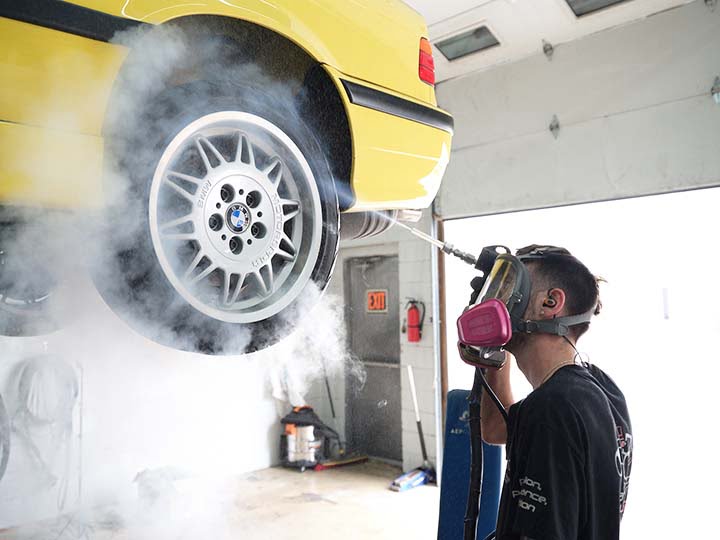चाहे आप एक बीमा समायोजक, व्यवसाय स्वामी, ठेकेदार, बिल्डर, या गृहस्वामी हों, आप संभवतः गंभीर सफाई चुनौती का सामना कर रहे हैं और सोच रहे हैं कि इससे बेहतर कोई तरीका क्यों नहीं है!
खैर, अब वहाँ है. अब किसी भी स्थिति में लगभग किसी भी चीज़ को साफ करने का एक बेहतर तरीका है। यह "बेहतर तरीका" क्या है? सूखी बर्फ नष्ट करना!
सूखी बर्फ क्या है?
सबसे पहले, आइए चर्चा करें कि ये चीजें वास्तव में क्या हैं……
सूखी बर्फ बिल्कुल भी "बर्फ" नहीं है।
वास्तव में, यह वास्तव में एक जमने वाली गैस है - सटीक रूप से कहें तो कार्बन डाइऑक्साइड गैस। तो इसका मतलब है कि हम बर्फ जैसे इस अजीब पदार्थ को नहीं देख सकते हैं, इसका मुख्य कारण यह है कि यह पिघलता नहीं है - यह "उदात्त" हो जाता है।
ऊर्ध्वपातन (अपेक्षाकृत) कठोर जमे हुए कार्बन डाइऑक्साइड "सूखी बर्फ" कणों को वापस गैसीय वाष्प में परिवर्तित करने की क्रिया है। ऊर्ध्वपातन तब होता है जब जमी हुई गैस गोली से अधिक द्रव्यमान वाली किसी वस्तु या सतह से टकराती है। जैसे ही उर्ध्वपातन होता है, गोली पूरी तरह से गैस में गायब हो जाती है।
सूखी बर्फ बनाने के लिए सबसे पहले तरल कार्बन डाइऑक्साइड से भरे उच्च दबाव वाले कंटेनर का उपयोग करें। फिर तरल कार्बन डाइऑक्साइड को टैंक से सावधानीपूर्वक निचोड़ा जाता है, तरल फैलता है, और कार्बन डाइऑक्साइड वाष्पीकरण की उच्च दर तरल को उसके हिमांक तक ठंडा कर देती है, जहां यह सीधे ठोस में बदल जाता है। इस ठोस को ब्लॉक, छर्रों या यहां तक कि बर्फ जैसी सामग्री में भी बनाया जा सकता है।
सूखी बर्फ क्या साफ कर सकती है?
"तो ये जादुई कण क्या साफ़ करेंगे," आप पूछते हैं।
आइस क्यूब सफाई प्रक्रिया आसानी से, साफ-सुथरी और कुशलता से प्रदूषकों को साफ कर देगी
चर्बी, तेल और विभिन्न पेट्रोलियम उत्पाद
काटने वाले तेल, विविध स्नेहक, जैल और पेस्ट
पुराना, ढीला पेंट
साँचे को हटाना
जली हुई लकड़ी, कालिख हटाना
फफूंदी हटाना
दीवारों, छतों आदि पर चिपकी गंदगी, गंदगी और मलबा...
रबर और इंजेक्शन मोल्ड स्क्रैप
ईंट, चिनाई और कंक्रीट पर चिपका हुआ पुराना प्लास्टर, मोर्टार और मलबा
सूची जारी है……
ज्यादातर मामलों में, अधिकांश दूषित पदार्थों को साफ करने के लिए सूखी बर्फ का उपयोग किया जा सकता है। और, क्योंकि सूखी बर्फ गैर-प्रवाहकीय है, यह सफाई प्रक्रिया इलेक्ट्रॉनिक घटकों और संवेदनशील कंप्यूटिंग घटकों के लिए भी उपयुक्त है।
ड्राई आइस ब्लास्ट सफ़ाई कैसे काम करती है?
तो अब हम समझते हैं कि उच्च दबाव में तरल CO2 को बाहर निकालने से CO2 कण कैसे बनते हैं। गोली के रूप में CO2 को एक इंसुलेटेड कंटेनर में तब तक संग्रहीत किया जाता है जब तक कि यह ब्लास्ट सफाई ऑपरेशन में उपयोग करने के लिए तैयार न हो जाए।
छर्रों को पहले एक हॉपर में लोड किया जाता है जो छर्रों के साथ हवा के दबाव (आमतौर पर एक वाणिज्यिक वायु कंप्रेसर द्वारा प्रदान किया जाता है) को जोड़ता है और इस हवा/गोली मिश्रण को "बंदूक" में निर्देशित करता है। इस मामले में, "बंदूक" बस एक ट्रिगर या स्विच द्वारा नियंत्रित नोजल है जो ऑपरेटर को संपीड़ित हवा और CO2 छर्रों के प्रवाह को लक्षित करने और नियंत्रित करने की अनुमति देता है।
गोली और संपीड़ित वायु मिश्रण को 80 पीएसआई और 350 पीएसआई के बीच की गति से चलाया जाता है। निचली गति का उपयोग छोटी, नाजुक सफाई प्रक्रियाओं के लिए किया जाता है, जबकि उच्च गति का उपयोग कठोर संदूषकों और भारी दूषित सब्सट्रेट्स की सफाई के लिए किया जाता है।
संदूषक "तेजी से जमे हुए" होते हैं क्योंकि कण और संपीड़ित हवा साफ की जाने वाली वस्तु पर प्रभाव डालते हैं। यह तेजी से जमने की प्रक्रिया सब्सट्रेट की सतह और उस संदूषक के बीच के बंधन को तोड़ देती है जिसे हम हटाना चाहते हैं। फिर हवा का दबाव प्रदूषक को सब्सट्रेट से "उड़ा" देता है, और प्रदूषक बस फर्श पर गिर जाता है। फिर सामूहिक कचरे को स्थानीय कानूनों और विनियमों के अनुसार सुरक्षित रूप से साफ किया जा सकता है और निपटाया जा सकता है।
हम क्या करते हैं?
SHULIY एक पेशेवर ड्राई आइस मशीन निर्माता है जिसके पास समृद्ध अनुभव और मजबूत क्षमता है। हमारे उत्पादों में विभिन्न ड्राई आइस उपकरण शामिल हैं, जैसे ड्राई आइस ब्लॉक मशीन, ड्राई आइस ब्लास्टिंग मशीन, ड्राई आइस ग्रेन्युल मशीन, ड्राई आइस ब्रिकेट मशीन, आदि। हमारी सभी मशीनों की गुणवत्ता उच्च है और प्रदर्शन अच्छा है। अधिक उपयोगी जानकारी के लिए हमसे संपर्क करने के लिए आपका स्वागत है।

